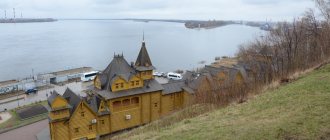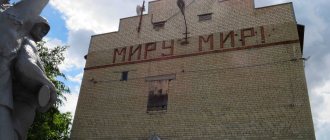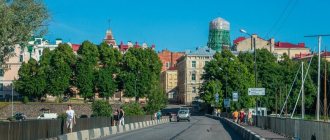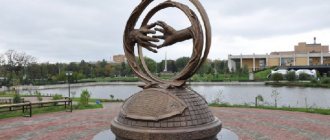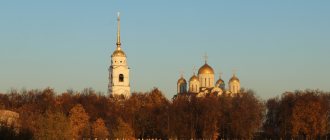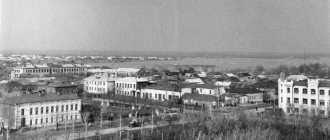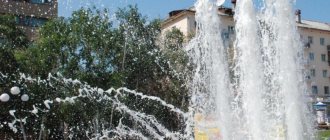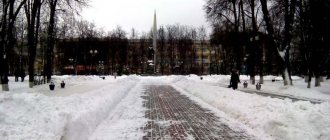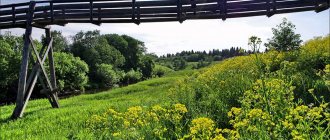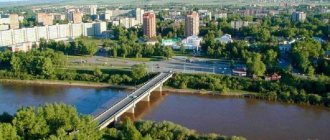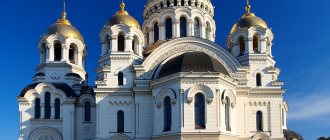History of Vasilyevsky Island
Vasilyevsky Island was mentioned in the “census book” in 1500. According to one legend, this name arose from the name of Vasily Selezny, its owner, mayor from Novgorod. The island began to be developed simultaneously with the founding of the Northern capital at the beginning of the 18th century.
Architect J.-B. Leblon developed a project approved by Peter the Great. According to his idea, it was assumed that this territory would become the center of the city. Many famous architects and sculptors worked to create this area. The building of the Twelve Colleges is located here (design by D. Trezzini). At the beginning of the 18th century, it housed 12 colleges, the Senate and the Synod, and currently it houses the St. Petersburg State University.
The Menshikov Palace is being built nearby (today it is formally one of the branches of the Hermitage). The Academy of Sciences was built according to Quarenghi's design.
Prince A.D. Menshikov ordered to cut a clearing from his Palace to the west, to the Baltic Sea. This clearing was called the Bolshoi Perspektiva, and later - the Bolshoi Prospekt. The basis of this area is made up of Bolshoy, Maly and Sredny avenues, which intersect with street lines with numbers as their names. Until the 70s of the 18th century, there were canals along a number of lines. And when they became shallow, they were buried. The word "line" does not mean the street, but the side of the canal.
The first residential buildings and churches appeared next to Bolshoy Prospekt. Most of them have survived to this day, only slightly changed. Here are located such architectural monuments as the building of the Academy of Arts, the building of the Mining Institute, the House of Academicians, in which 26 great Russian scientists lived at different times, the building of the Gostiny Dvor and many others.
Not far from the building of the Twelve Colleges there is a monument to M.V. Lomonosov, in front of the building of the Naval Cadet Corps - a monument to I.F. Krusenstern.
Near the building of the Academy of Arts there are two stone sphinxes looking at each other. (The Sphinx is a mythical creature with the head of a man and the body of a lion).
The Lutheran Church of St. Catherine is of great historical and cultural value. St. Catherine's Church is an active German parish of the Evangelical Lutheran Church. The temple with 1100 seats was founded in June 1768.
Businesses and work in the area
Despite its small territory, Vasilievsky Island accommodates about 30 large industrial enterprises, 80% of which work for the defense industry, as well as about 6 thousand small commercial establishments of various specializations. It so happened historically, since the time of Peter I, that the Vasileostrovsky district is a special territory that gives its residents the opportunity to both live and work. However, in reality everything turned out completely differently.
Large enterprises here are represented by the ancient Becker piano factory, the Baltic Shipbuilding and Steel Rolling Plant, Elektroapparat, Northern Textiles, the Tannery named after. Radishchev, there is an Automobile Repair Plant, a plant named after. Kalinina, the famous Rot-Front factory throughout Russia and others.
Baltic plant. Photo by udva (https://fotki.yandex.ru/users/udva)
Gavan is also of great economic importance for the region and the city as a whole - recently the first stage of the “Marine Façade” project was implemented: the sea passenger port of St. Petersburg, intended for cruise ships, was put into operation. Thus, the port located on Vasilievsky Island acquired not only commercial, but also tourist significance.
In general, the “Marine Facade” project means a lot for the development of the area, significant investments have been attracted, and, despite all the warnings from ecologists about the inexpediency of creating such a number of alluvial areas, the project is gaining momentum.
In the area there are several shopping malls selling clothing and footwear from leading European casual brands; hypermarket "Lenta" and St. Andrew's market.
Pedestrian streets on Vasilievsky Island (lines 6 and 7)
It is generally accepted that there are 10 pedestrian streets in St. Petersburg. One of the most beautiful is the 6th and 7th lines of Vasilyevsky Island. The most beautiful part of the street is located between Bolshoy and Sredny Avenues of Vasilievsky Island. This part of the street is also called Andreevsky Boulevard. You can get here by metro - when leaving the Vasileostrovskaya station, turn right and you will find yourself in the pedestrian zone.
Here you will see a blue horse-drawn carriage (late 19th - early 20th century).
In the middle part of the street there is a boulevard with growing larches and two fountains. Lots of shops, cafes, bars and restaurants. In the middle of the street there is a monument to Vasily.
Crime situation in the area
The criminal situation in the Vasileostrovsky district is relatively calm compared to some other regions of St. Petersburg. Of course, in the 90s, the proximity of the Harbor and the presence of expensive restaurants on the island’s embankment made the area to some extent attractive to bandits - they shot here quite often. Plus, the “old” new buildings in the Primorskaya area were places where drugs were sold and bought, but today the situation is much better.
House-ships near Primorskaya
A lot of crime in the area is associated with car and apartment thefts, as well as road accidents, especially at night. Not always sober reckless drivers, confident in their impunity, like to drive along empty embankments and avenues, and sometimes this ends tragically.
Monument to Vasily Korchmin
On May 24, 2003, a monument to Vasily was unveiled, designed by a sixth-year student at the Academy of Arts, Grigory Lukyanov. His colleague Sergei Sergeev joined the work on the monument.
According to legend, during the construction of the Peter and Paul Fortress, on the contrary, at the tip of the island - Strelka, an artillery battery was built to protect the entrance to the Neva from the Swedes, commanded by bombardier lieutenant Vasily Dmitrievich Korchmin. Peter I sent him orders and instructions with a laconic inscription: “To Vasily on the island.” And after his death, the island was named in memory of Vasily Korchmin. Vasily, created by him, is made in the image of a bombardier lieutenant of Peter the Great's time. At the end of the street you can see 2 temples.
Walking routes: best routes
The island is about 3.5 km long and is an excellent place for walking excursions. Most often, excursions begin opposite the entrance to the Vasileostrovskaya metro station. From there you can walk to the ancient pharmacy of Doctor Pel and his sons. This is a unique place of power. Everyone who crosses the threshold of a pharmacy gets a chance to change their life. According to legend, in the basement of a pharmacy, the Doctor deduced the formula for the philosopher's stone, which helps him travel in parallel worlds.
In the backyard is the Griffin Tower. They say that there the doctor brought out these mystical creatures. Rumors about this are fueled by mysterious numbers on the tower. Who exactly left them, what they mean is still not known for certain. Maybe there’s a code for immortality hidden there, or maybe it’s just someone’s joke.
Afterwards the group goes to the building of the Faculty of Philology. This place is also shrouded in mystery. On a full moon, you can see the ghost of a student who was tortured to death by strict examiners. The ghost is harmless, it only sighs bitterly, but does not harm anyone.
There is another interesting object that few people know about. This is the building of the Optical Institute with a magnificent observation deck from where you can see the Neva embankment. Another popular tourist route is a walk through the scientific sites of Strelka. Surprisingly, the most famous scientific institutions in Russia are located on the island. Amazingly, the small island was considered a center of science and education.
Church of the Three Saints
The Church of the Three Saints, named after Saints Basil the Great, Gregory the Theologian and John Chrysostom, was assigned to St. Andrew's Cathedral, at which it was founded as a warm building in 1740 according to the design of Carlo Giuseppe Trezzini. This is one of the oldest stone churches in the city. During Soviet times, this church housed a knitting factory. On July 15, 1991, the church was transferred to St. Andrew's Cathedral, which uses it after restoration for early liturgies.
On February 12, 2001, the church was consecrated by Metropolitan of St. Petersburg and Ladoga Vladimir.
A walking tour is always an important and interesting part of a road trip. Today's walk through the secondary attractions of Vasilievsky Island in St. Petersburg is a completely independent event. If only because I live in this city. This trip is timed to coincide with the arrival of our friends from Orenburg. Four adults make up the group. Spending time together for 8 hours, from 14:00 to 22:00. Two “intermissions” per 10 km.
Model copy of a St. Petersburg horse-drawn carriage.
Right next to the Vasileostrovskaya metro station we see a life-size, two-story, two-horse model of a horse-drawn horse.
It was economy class. Single-decker and one-horse horse-drawn carriages were intended for wealthy passengers. The fence upset me. Firstly, it’s ugly, and secondly, such bans are simply boring. If you're afraid they'll break it, do it better!
Monument to V. Korchmin.
Further along the pedestrian street we see a monument to Vasily Dmitrievich Korchmin (1671-1729), the closest associate of Peter the Great. According to legend, Vasilyevsky Island is named after Vasily Korchmin. He was a key figure in Peter's army: one of the creators of the best artillery of his time (as a branch of the military, including horse and naval artillery), designer of cannons and new types of weapons (inventor of combat missiles and a flamethrower), master of fortification and siege warfare.
On the website he is called a bombardier; in Peter’s time this was the name given to privates in the artillery. He was a major general. Looking at the monument, it is clear that it is too elegant for an ordinary person.
Church of the Three Ecumenical Saints.
Still on the same pedestrian street we find one of the oldest stone churches in St. Petersburg. It was founded on the 6th line of Vasilyevsky Island on July 2, 1740, according to the design of the architect Giuseppe Trezzini. Consecrated in 1760 in the name of the Three Ecumenical Hierarchs: Basil the Great, Gregory the Theologian and John Chrysostom.
In 1916, when the Georgian diaspora in Petrograd numbered about 6,000 people, the church was given to the Georgian parish. Services were held here in Georgian. In addition, noble Georgians were buried near the church. To this day, there is an inscription on the wall in Georgian and Russian: “In this place, buried in the Georgian regiment of Mr. Major Prince Edisher Potalievich Amilakhvari, his wife Guka Nodarovna, who was 37 years old from birth, and died this year, 1745, on the 28th of March.”
After the revolution, the parish was closed and a knitting factory was located in the building.
Cathedral of the Holy Apostle Andrew the First-Called.
Close to the church there is a beautiful cathedral, built according to the design of the architect A.F. Vista from 1761 to 1780 on the site of a burnt wooden church.
There is a wonderful wooden iconostasis inside.
Obelisk in honor of the 300th anniversary of the establishment of the Order of St. Apostle Andrew the First-Called.
There is a noticeable obelisk next to the cathedral. In case anyone doesn’t know, this short pedestrian street is called Andreevsky Boulevard. Everything is interconnected: the cathedral, the obelisk and the boulevard.
The Order of St. Andrew the First-Called was established in 1698 and on March 10, 1699, F.A. became its first holder. Golovin. The order was awarded to individuals for military exploits and public service. The motto of the order: “For faith and fidelity.”
During Peter's lifetime, thirty-eight people were awarded the highest state award in Russia, two of them - Hetman I.S. Mazepa (the second to be awarded) and the French engineer J.G. Lambert de Guerin - were later deprived of this order. Peter I himself and Prince A.D. Menshikov received the seventh and eighth orders in 1703 for the capture of two Swedish ships at the mouth of the river. Ekateringofki. There are two significant errors in the texts of the inscriptions on the obelisk. The obelisk was opened on June 8, and not on May 27 (as indicated on the monument). It was opened 302 years after the establishment of the Order of St. Andrew the First-Called, but the very first inscription on it indicates the wrong date of establishment of the order - 1720, which contradicts the very meaning of the monument. Thus, this monument represents a rare example of a distortion of the date of the event in memory of which it was erected, and also incorrectly indicates the date of its own opening.
Apartment house of M. A. Dolgopolov.
The house at 8th line VO, 31 interested me not so much in late modernism, which I am not good at, but rather in its residents. It was built in 1910-1911 by architect. Van der Gucht Wilhelm Ivanovich. The customer was merchant Dolgopolov Maxim Alexandrovich, a hereditary honorary citizen. Trade in building materials, pottery and cement slabs for floors and walls and facing bricks.
E. E. Mandelstam lived in this house, and Osip Emilievich Mandelstam stayed with him. It was here that he wrote the famous poem Leningrad in 1930: I returned to my city, familiar to tears, to the veins, to the swollen glands of children. You have returned here, so quickly swallow the fish oil of Leningrad river lanterns, quickly recognize the December day, where the yolk is mixed with the ominous tar. Petersburg! I don’t want to die yet: You have my phone numbers. Petersburg! I still have addresses where I can find the voices of the dead. I live on a black staircase, and a bell torn out with meat strikes my temple, And all night long I wait for my dear guests, Moving the door chains with shackles. December 1930.
Here lived the sociologist P. A. Sorokin (1889-1968) with his wife, a man with an extraordinary destiny, rejected by his homeland. From here the couple went abroad forever, where Pitirim Sorokin gained worldwide fame. As usual, the best minds are welcomed in the United States, and our country is proud of its compatriots.
In Syktyvkar I saw a monument to P. A. Sorokin. There were other respected residents, but I wrote only about those who can be recognized by walking down the street and reading memorial plaques.
House of Zablotsky-Desyatovsky.
This nondescript house was built in 1830 in the classicist style on the 8th line of VO, 39.
In 1851, Andrei Parfenovich Zablotsky-Desyatovsky, a statesman, scientist and writer, became the owner of the house.
In 1861-1914. P.P. Semenov-Tyan-Shansky, son-in-law of Zablotsky-Desyatovsky, a scientist-geographer, lived and died in the house. Which, by the way, in 1911 was awarded the highest Russian insignia - the Order of St. Andrew the First-Called. In the fall of 1855, the family of I. P. Tchaikovsky, the father of the great composer, moved to the house on the 8th line, 39. Young Pyotr Ilyich Tchaikovsky (1840-1893) was given a small room where he lived while studying at the School of Law. The romance “My genius, my angel, my friend” was written here. In the courtyard transverse wing at the back of the courtyard in 1860-1863. lived the artist I. N. Kramskoy.
This house was not in the plan, but the memorial plaques “worked.”
Memorial plaque to A.P. Sumarokov (11/25/1717 - 10/12/1777).
I marked this place in advance after seeing the mark on MAPS.ME.
Alexander Petrovich Sumarokov was born on November 25, 1717 in Finland - not far from Vilmanstrand (Lappenranta). He graduated from the Land Noble Cadet Corps in 1740. In 1756 he became the first director of the Russian Theater, now it is the Alexandrinsky Theater in St. Petersburg. Published "The Hardworking Bee" - the first Russian private magazine entirely devoted to literature. Sumarokov was known not only in Russia, but also abroad: in 1759 he was elected an honorary member of the Leipzig Academy of Sciences. During the playwright's lifetime, all of his tragedies were translated into French. Alexander Sumarokov died on October 12, 1777 in Moscow. A few months before his death, he had to sell the remains of his library and house. I do not approve of such frivolity, given that the poet was buried at the expense of Moscow actors at the Donskoye Cemetery in Moscow.
Monument to the sundial of besieged Leningrad.
A modest place, naturally, with history.
One of the many problems of besieged Leningrad was the city clock not working. On the initiative of professor of astronomy V.I. Pryanishnikov, in the spring of 1943, a plywood sundial was installed on Vasilievsky Island, which stood until the end of the war - an amazing fact for a besieged city, especially if you remember that many sundials were destroyed by the war - in Peterhof, Strelna, Gatchina . The blockade sundial was popular - meetings were scheduled near it, passers-by stopped near it and shared news from the front. This structure gave me strength to hold on. There was hope in him for a peaceful life, which would definitely come. The blockade sundial was recreated in granite in 2016 on the initiative of the administration of the Vasileostrovsky district of St. Petersburg. The authors of the project are V. Dmitriev and N. Yashin.
None of us were able to tell the time using this watch.
Mansion house of P. Lopez -Printing house of the Academy of Sciences.
This house catches your eye. The name of the author of the project has not been established.
On the corner plot No. 28/12 in the 18th century. there were wooden buildings. The mansion house with a mezzanine was built in 1808-1810. for the Portuguese consul and wine merchant Pedro Lopez. The house served not only as his residence, but also as a hotel for his compatriots. The huge basements of the house served as a wine warehouse. Lopez was an active supporter of trade relations between Portugal and Brazil and Russia, and in 1810 he became consul general. In the 1820s. Lopez's house was sold for debts. It was purchased by the merchant E.F. Ganin. In 1825 the house was rented for the printing house of the Academy of Sciences, and in 1829 it was bought. In 1829-1830 arch. D. E. Filippov partially rebuilt the house in accordance with the needs of the printing house, and he also built a balcony. In 1859-1860 on the site of the dilapidated services, a three-story courtyard building in the style of the main house was erected.
Monument to V.I. Lenin.
Where would we be without the leader of the revolution?
The bronze monument to Lenin was unveiled on July 17, 1930. The full-length figure of the leader, two meters high, is installed on a high pedestal made of pink granite, stylized as a tribune.
Chapel of St. Spyridon of Trimifuntsky.
This Empire style chapel was built in honor of the centenary of the Finnish Life Guards Regiment in 1904.
At the beginning of 1923, its iconostasis was taken to the Museum of an Obsolete Cult, and the rest of the decoration was taken to the Smolensk Cemetery Church. Chapel of St. Spyridon since 1995 belongs to the Church of St. Catherine at the Academy of Arts.
Monument to the feat of Leningrad firefighters.
We look at the monument erected in front of the red brick fire department building and dedicated to the people of this profession who died at their combat post during the Second World War.
Due to the non-standard composition (the author took an ancient Roman sculpture as a basis), the monument languished in the courtyard of the 9th fire station for more than ten years. Since 1995 it has been available for public viewing.
"Garden Vasileostrovets"
Small in size, well-groomed and pleasant.
Its history began at the end of the nineteenth century, when in 1887 a summer theater was built on the territory of the Smolensk Field, around which a garden was laid out. Visiting the garden at that time was free only on weekdays, and paid on weekends.
The modern appearance of the park was formed after the Great Patriotic War. The garden has the shape of a rectangle. In 2010, a monument to the artist and public figure N.K. Roerich was erected at the western entrance to the park. The park is equipped with several children's playgrounds.
Monument to N.K. Roerich.
The dominant feature of the garden is a monument made of Karelian granite 3.5 meters high. Opened November 9, 2010.
Sculptor V.V. Zaiko, architect Yu.F. Kozhin. The years of study and formation of the artist are associated with Vasilyevsky Island. Here was the gymnasium of K.I. May, where he received his secondary education. The personality of Nicholas Konstantinovich Roerich (1874-1947) is so multifaceted that not everyone can immediately say what he is famous for. Roerich is mainly known as an artist, but he was also a stage designer, mystic philosopher, writer, traveler, archaeologist, orientalist and public figure.
Sobchak Square.
The area appears to be a large parking lot.
It appeared in 1937 after the construction of the Palace of Culture named after. Kirov. It received its name on January 17, 2005 in memory of Anatoly Sobchak (1937-2000), mayor of St. Petersburg (1991-1996).
Monument to A. A. Sobchak.
In the park at the intersection of Bolshoi Ave. Vasilievsky Island and Club Lane we see a monument. It was installed on June 12, 2006. Sculptor Ivan Borisovich Korneev, architect Vyacheslav Borisovich Bukhaev. Bronze, granite. Half figure 1.5 life size.
I don’t understand these half-figures, it’s some kind of nonsense.
Monument to V.I. Lenin.
Another Ilyich.
In front of the main building of the hospital. V.I. Lenin (now called Pokrovskaya) in 1934, a monument to V.I. Lenin by sculptor Veniamin Borisovich Pinchuk was erected. Initially, the bronze figure was installed on a concrete base, which was replaced with granite in 1960. The height of the monument is about 4 meters, of which the figure of the leader is 2 meters.
Apartment house of A. A. Eremeeva.
The six-story red brick house was noted for its beauty and corner bay window topped with a hipped spire.
Built in Art Nouveau style in 1902-1905. according to the project of the architect. M. F. Eremeeva. The architect built it for his wife, A. A. Eremeeva, who was a doctor. In the early 1900s. there was a club for workers of the Baltic plant. It was a hall on the second floor, rented from the owner of a tea shop.
On the facade of the house there is a memorial plaque: “In this house in the former workers’ club in June 1906, V.I. Lenin spoke at a meeting of the Social Democratic organization of the Baltic Intermission” is not accidental.
I like microbreweries and taprooms. A taproom is a bar at a brewery, or a brewery at a restaurant. In our case, the second option.
It's not worth going here for lunch, you'll only be disappointed.
A light snack and a couple of beers are just right. Beer is served in the American style in 0.4 l glasses, and for stronger ones in 0.25 l containers, I took the strong Atomic Laundry (IPA from Jaws Brewery). The highlight of the program was the local Gypsy Jewish Beer lager.
Opochinsky garden.
After the intermission everything becomes more beautiful.
I wanted to photograph the garden, created in 1937, near the industrial zone.
It has undergone a major renovation so it looks good. In 2011, the Alley of Love was founded here, which begins at a tree cast from metal.
The newlyweds attach locks from their hearts to its branches, and the keys are dropped into a fabulous forged chest, securely attached to the tree trunk.
Monument to Musa Jalil.
And again a monument, this time to the Tatar poet and Hero of the Soviet Union Musa Jalil. It was opened on May 19, 2011 and is a gift from the Republic of Tatarstan to St. Petersburg.
During the Great Patriotic War, Musa Jalil near Leningrad, with the rank of senior political instructor, served as a war correspondent for the newspaper “Courage”; in 1942 he was captured and then sent to a concentration camp. Finding himself as part of the Volga-Tatar Legion “Idel-Ural”, he became a member of the underground organization. After the discovery of the underground, he was executed along with other 11 Tatar legionnaires by guillotine on August 25, 1944 in Plötzensee prison in Berlin. Sculptor Akhnaf Ziyakaev.
Galernaya harbor.
We came across Galernaya Harbor. It is a monument of fortification art. It all started in 1721 with a project by the architect Domenico Trezzini. Then there were many other architects, projects, events.
On the shore of this harbor is the oldest yacht club in Russia.
Like in Finland.
Water tower.
To supply water to the pyroxylin plant, a Water Tower was erected in 1894 on the western shore of Galernaya Harbour, on Shkiperskaya Protoka, 25, according to the design of engineers Kutorikh and Yakovlev.
Currently it is privately owned.
Monument to Admiral P. S. Nakhimov.
Our strength is already running low, but we continue our tour of the secondary attractions of Vasilyevsky Island. I think some people might not like this name. But things must be called by their proper names. In front of us is the “Malye Havantsi” square, created in honor of the first victory of Russian ships at sea, near Galernaya Harbour. In the center of the square there is a monument opened in 2012 in honor of the 210th anniversary of the birth of Pavel Stepanovich Nakhimov (1802-1855).
Monument to Peter the Great.
Next is the monument to the first Russian emperor.
Digression into the topic: with his decree in 1721, D. Trezzini began designing the Galernaya Harbor. Another semantic connection: harbor, square, monument. It's always interesting to find such connections.
The six-meter bronze Peter I by Zurab Tsereteli is the urban dominant feature of the sea facade of St. Petersburg.
He carries out eternal watch and is the first to greet guests of the Northern capital arriving in the city by water. The architects of the monument are considered to be Romanovsky and Chernov.
Sculptural composition “The Conquered Baltic”.
The Soviet-style monument is located in front of the main entrance to the Pribaltiyskaya Hotel. 1982, sculptor E. M. Agayan.
Back then they loved to conquer anything.
Bar Mollie island.
I would like to call the distance between the two bars a “beer mile,” but in fact we walked two miles. We were hungry and tired. The approaching twilight accelerated the second “intermission”, although plans also included a monument to the cruiser Kirov. Despite the fact that the establishment is Irish-style, we were recommended pizza for dinner. They really cook it well here. The beer headliner was the Belgian Rouge de Brussels.
A monument to all pioneers and explorers of the polar regions of the planet.
After dinner we head to the finish line. Already in the dark we approach an interesting monument.
White silence, in the center of which is a person - this image is embodied in the monument to all Russian polar explorers, the grand opening of which took place on September 9, 2022, near the building of the Arctic and Antarctic Research Institute of Roshydromet (AARI) in St. Petersburg.
The inscription is carved into the white granite: “To those who walked first, to those who are walking now, to those who still have to go.”
These words will be the final point on our excursion.
St. Andrew's Cathedral
At the intersection of the 6th line with Bolshoy Prospekt there is the Orthodox Church of St. Apostle Andrew the First-Called, one of the oldest in the city - St. Andrew's Cathedral. The Order of St. Apostle Andrew the First-Called is the first Russian order, established by Peter I in 1698. The sign of the order is located above the entrance to the cathedral. On the alley there is an 8-meter obelisk made of granite, built to mark the three hundredth anniversary of the establishment of this award (architects A.A. Kazankov and Yu.V. Sitnikov)
Petersburg Metro Museum
The Metro Museum in St. Petersburg is a quiet place, mainly because few people know about it. If you take the metro, you can get here by reaching the Primorskaya station, on the same Vasilyevsky Island.
The entrance to the building itself is next to the metro station, look carefully so as not to miss it. Visiting the museum is free if you view the exhibits yourself.
To do this, you need to call, make an appointment, and present documents at the entrance. For those who want to listen to the history of the metro and the appearance of exhibits, paid guided tours are created.
The cost of the excursion must be confirmed with the museum administration. The official website of the establishment is here
https://dosug.metro.spb.ru/metro-museum/
It’s quite nice to take a walk on your own. It’s interesting to look at the driver’s cabin, what the subway cars were like, and the surroundings.
On the way from the museum you can buy souvenirs and sweets with a subway theme. You won’t see anything unusual here, if the metro is not that interesting and you don’t have much time in St. Petersburg, feel free to choose another leisure option.
The museum is located at Odoevskaya street, No. 29.
Museum on the map:
Exchange on Vasilyevsky Island
The central building of the architectural ensemble of the Spit of Vasilievsky Island is the Exchange building, built according to the design of the French architect J.F. Thomas de Thomon in the style of classicism.
The facades of the Exchange are decorated with sculptural groups symbolizing the ocean, rivers and navigation (authors I.P. Prokofiev and F.F. Shchedrin). In front of the Exchange we see the famous rostral columns (sculptors I. Camberlain and J. Thibault).
The Northern and Southern warehouse buildings were built on both sides of the Exchange (designed by I.F. Lukini).
On February 11, 2010, a new exchange building was opened. In addition to the stock exchange, the building housed a business center and a bank. Due to the excess of the height regulations, after the intervention of the city authorities, the upper floors of the building were dismantled.
Bridges of Vasilyevsky Island
The Blagoveshchensky and Palace bridges connect the island with the city center, the Betancourt, Tuchkov and Birzhevoy bridges connect the island to the Petrogradskaya side.
The narrowest street in St. Petersburg
On Vasilyevsky Island there is the narrowest street in the city - Repina Street (formerly Peschany, Solovyovsky Lane). Its width is 5.6 m. It runs between the 1st and 2nd lines, from Rumyantsevsky Garden to Sredny Prospekt, crossing Bolshoy Prospekt.
The main advantage of Vasilyevsky Island in St. Petersburg is its proximity to the city center. Therefore, it is especially convenient to stay here for guests who come to get to know the city, and for those who arrive on a business trip and plan to visit the Lenexpo Exhibition Complex. But we must keep in mind that at night in the summer the island becomes practically cut off from the rest of the city due to the opening of bridges. In recent years, this problem has been partially solved - you can get to the Petrogradskaya Strona through the Betancourt drawbridge, to the airport and other areas of the city - via the toll Western High-Speed Diameter, in addition, on weekends there is a metro shuttle train between the Admiralteyskaya stations (in .
Municipal division of the area and property prices
The district is divided into 5 municipal districts: districts No. 7, 8, 9 (Gavan), 11 and the Marine Municipal District.
Map of Vasileostrovsky district
The boundaries of the 7th municipal district of the Vasileostrovsky district run along the Makarov embankment, Sredny Prospekt, along the 24-25th line to Bolshoy Prospekt and Detskaya Street, along the Kosaya Line, Neva Bay, the Bolshaya and Malaya Neva embankments. This is one of the large municipal districts, mainly consisting of residential “old” stock and industrial zones. There are many unoccupied and, from the point of view of realtors, practically hopeless communal apartments in the area. Green spaces are represented by courtyard public gardens. You need to get to any of the two metro stations by additional ground transport. Only some residential areas located in the center of the island allow you to quickly, and sometimes simply on foot, get to the Vasileostrovskaya metro station.
The cost of a square meter of housing in the district ranges from 90 to 110 thousand rubles per square meter, however, apartments are bought here reluctantly - there are almost no “one-room offers”, and multi-room housing often needs very serious repairs and necessarily replacement of outdated communications. The resettlement of communal apartments has also stopped due to the crisis; it is becoming increasingly difficult for realtors to find people willing to live in the old stock, because many proposals for new luxury housing have appeared on the real estate market.
The 8th municipal district is mainly a Stalinist development of Bering Street, the western part of Maly and Sredny Avenues, Nalichnaya Street and the embankment of the Smolenka River. Here, real estate is more expensive, the air is cleaner, there is better transport and greenery - nearby is the Smolensk Memorial Cemetery, where it is quite pleasant to walk in the summer. The disadvantages of living here are also some distance from metro stations and inevitable traffic jams when trying to get to the mainland during the day.
Among the residential buildings here, Stalinist buildings and brick houses predominate. This is spacious, comfortable housing, with a convenient layout, quite promising for implementation. The cost per square meter on the secondary market reaches 120 thousand rubles per square meter. New housing of the “economy” and “comfort” classes is also being built in the same district. The offers are very diverse, from small studio apartments, which are very popular among out-of-town students who are happy to settle close to their university, to 4-room apartments designed for large families. Since the real estate market is currently experiencing some difficulties, among primary housing in this district you can find offers starting from 90 thousand rubles per square meter.
Harbor or the 9th municipal district is the territory bounded by Bering, Nakhimov and Korablestroiteley streets, as well as Morskaya Embankment, Nevskaya Guba, Europe Square and the western sections of Kosaya Liniya, Detskaya Street and Bolshoy Prospekt. This is the area of Gavan and Lenexpo in the Gulf of Finland, wedge-shaped deepening into the center of the island. The main industrial enterprises are located here, and residential development is represented by almost all types of houses - from the Peter the Great's foundation to modern new buildings.
The district is distinguished by its convenient location relative to all public transport routes; individual blocks are within walking distance from the Primorskaya metro station. However, constant humid and cold winds from the bay, from which even the highest quality thermal insulation of residential premises cannot protect, can make living here somewhat uncomfortable. The price per square meter here depends on the type of residential development and the “status” of the house. On the real estate market there are offers for 80 thousand rubles per square meter, and for 150 thousand rubles and above.
Municipal district No. 11 includes Sulfur Island, western territories along the Smolenka River and Malaya Neva. This is the Primorskaya metro area with all its new buildings - “old” and new. It is the windiest, coldest and most expensive here. This is a modern development with developed infrastructure, mostly good transport links and no traffic jams. To the east there are industrial zones and areas occupied by various commercial premises, but pollution is not felt here. The average cost per square meter here is 110-115 thousand rubles, but in “old” new buildings - series 137 - you can find it much cheaper, about 80 thousand rubles per sq.m.
This is a modern development with developed infrastructure, mostly good transport links and no traffic jams. To the east there are industrial zones and areas occupied by various commercial premises, but pollution is not felt here.
And the last district of the Vasileostrovsky district - the Morskoy District - is located from Nalichnaya Street along Bering to Nakhimov, and further along Korablestroiteley to the Pribaltiyskaya Hotel, along the Neva Bay to the Smolenka River and closes along Smolenka to Nalichnaya and Bering. This is also a relatively clean area, which is currently affected by the large-scale construction of the “Sea Facade”. Today this is the most elite and promising residential sector on Vasilyevsky Island. The “Marine Facade” complex involves the construction of hundreds of thousands of square meters of “business class” and “comfort” class housing. According to realtors, the cost of housing here will reach 150-160 thousand rubles per square meter, and this is not the limit. However, there are also more economical offers. Living here is pleasant and convenient, the district is safe, with developed infrastructure. If again, it weren’t for traffic jams and wind, but this is a problem for the entire Vasileostrovsky district as a whole.
